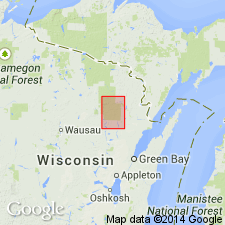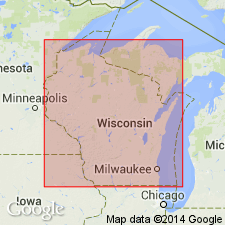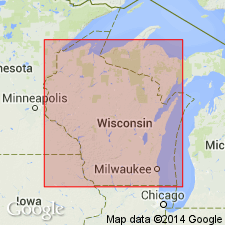
- Usage in publication:
-
- McCaslin formation
- Modifications:
-
- Original reference
- Dominant lithology:
-
- Quartzite
- Conglomerate
- AAPG geologic province:
-
- Lake Superior region
Summary:
McCaslin formation. Formation unconformably overlies Waupee series (new). Composed of a basal conglomerate which grades upward into clean quartzite. Maximum thickness about 5,000 feet. Unconformably underlies Hager rhyolite porphyry (new). In contact with younger High Falls granite (new) in several areas. McCaslin formation furnishes structural framework for regional [McCaslin] syncline. Middle Precambrian or Huronian but exact position in Huronian not clear.
Source: US geologic names lexicon (USGS Bull. 1350, p. 448-449).

- Usage in publication:
-
- McCaslin quartzite
- Modifications:
-
- Overview
- Dominant lithology:
-
- Quartzite
- AAPG geologic province:
-
- Lake Superior region
Summary:
Pg. 2, 3 (geol. map), 5, 8. McCaslin quartzite. Presumably same as Thunder Mountain quartzite (new). Study area in vicinity of McCaslin syncline in southeastern Forest, western Marinette, and northern Oconto Counties, Wisconsin. Age not stated.
Source: US geologic names lexicon (USGS Bull. 1350, p. 448-449); GNU records (USGS DDS-6; Denver GNULEX).

- Usage in publication:
-
- McCaslin Quartzite
- Modifications:
-
- Overview
- AAPG geologic province:
-
- Lake Superior region
Summary:
Pg. 7-14. McCaslin Quartzite. A review of some problems of Precambrian geology of northeastern Wisconsin. Mancuso (1957, 1960, unpub. theses) established following succession: Waupee Volcanics, Macauley Granite, Baldwin Conglomerate and McCaslin Quartzite, Hager Rhyolite Porphyry, Belongia Granite and High Falls Granite. Significant contribution of this study was demonstration of two distinct ages of granitic intrusion: McCaslin Quartzite lies nonconformably on Macauley Granite and is intruded by High Falls Granite.
Source: US geologic names lexicon (USGS Bull. 1350, p. 448-449).
For more information, please contact Nancy Stamm, Geologic Names Committee Secretary.
Asterisk (*) indicates published by U.S. Geological Survey authors.
"No current usage" (†) implies that a name has been abandoned or has fallen into disuse. Former usage and, if known, replacement name given in parentheses ( ).
Slash (/) indicates name conflicts with nomenclatural guidelines (CSN, 1933; ACSN, 1961, 1970; NACSN, 1983, 2005, 2021). May be explained within brackets ([ ]).

